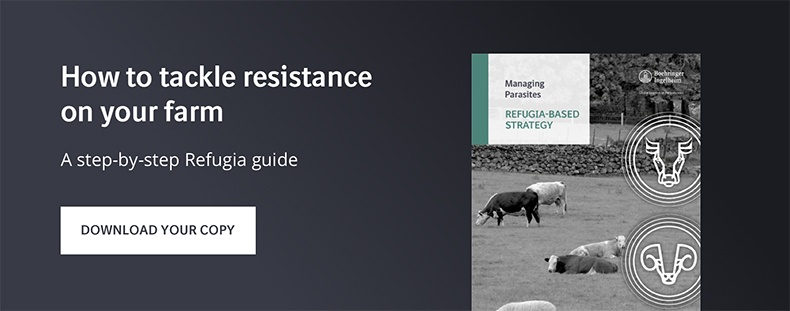Most common reason for poor performance
Parasitic infections are one of the most common reasons for poor performance and economic loss in cattle farming, even in the absence of clinical disease.
Reduced feed intake, weight gain and impaired fertility can be attributed to a parasitic burden in growing cattle. In replacement heifers the impact of parasites can extend into lactation, with reduced milk production. In dairy animals, this can result in reduced lifetime yield and poorer lifetime productivity.
Treating cattle for parasites can make a significant difference to productivity levels, and housing is an ideal time to do this.
Sustainable parasite control strategies important for health heifers
Sustainable parasite control strategies are increasingly important for the production of healthy heifers. Appropriate treatments will help to ensure they grow quickly, to their full genetic potential.
Heifers that calve at 24 months are more cost efficient, since they reduce the cost of producing replacements, have lower culling rates, and have the potential for increased lifetime profitability through additional lactation periods.
To achieve a 24-month average age at calving heifers must reach approximately 60% of mature weight by 14 months of age. This requires an average daily weight gain of at least 0.7-0.8 kg during the period between weaning and bulling.
Heifers have high nutrient requirements as they grow and get ready for calving. A heavy parasite burden will draw on these resources, reducing the nutrients available for growth and slowing the time they take to reach their mature weight and become ready to conceive.
In strategically-wormed heifers, studies have shown increased mammary development and earlier onset of puberty, compared to untreated animals1,2.
Monitoring heifer performance and diagnosing parasitic infections is therefore very important.
Consider performance of stock over grazing season
Before considering which anthelmintic treatment to use, it is worth considering the performance of the stock over the grazing season, and how it compared with expectations or targets.
Growth rates of young stock in their first and second grazing season are useful indicators of effective parasite control.
Losses in liveweight gain due to poor parasite control during a heifer’s first grazing season will not be recouped during the second year at grass3. Affected animals will not catch up, and this will impact on their ability to meet important growth milestones, which could result in an increased age at first calving.
Monitoring growth rates throughout the year will help to identify individuals that may require anthelmintic treatment.
Remove gutworms and liver flukes for parasite-free heifers in spring
Removing parasites such as gutworms and liver fluke at housing will help to ensure heifers are turned out parasite-free in the spring. This helps to reduce pasture contamination at turnout, thereby lessening parasitic infection in the next grazing season.
A targeted approach to parasite treatments at housing increases the sustainability of anthelmintic control and reduces the selection for resistant parasites. For this approach to be effective, farmers must be able to identify individual cattle that are likely to have a parasite burden. This can be achieved through weight records and targets, or diagnostic testing, such as faecal egg counts.
Alternatively, a strategic approach should identify groups of cattle for treatment based on a number of risk factors, including farm history, grazing practice over the summer, anthelmintics treatments while at grass, and any clinical signs of disease.
The type of parasites likely to be present at housing should guide your anthelmintic product selection.
While the important gutworm species Ostertagia ostertagi and Cooperia oncophora are often both present at this time of year, their sensitivity to anthelmintics does vary – so ask your animal health advisor for guidance.
Some combination treatments offer convenience by enabling the removal of a wider range of parasites, such as gutworms and liver fluke.
Resistance to the flukicide triclabendazole is an emerging issue in the sheep and cattle industries. Care should be taken to preserve it for use in sheep, where there is no other alternative for treatment of acute fluke disease.
Alternative treatments for fluke in cattle include those containing closantel, clorsulon or nitroxynil. These treatments may need repeating at the appropriate time after the initial housing dose to ensure that all juvenile and adult fluke are removed and cattle are turned out fluke free.
Dairy cows and heifers in calf have more restricted options for liver fluke control due to milk withdrawal periods. Advice should be taken from an animal health advisor.
Consider external parasites
Finally, consider external parasites such as mites and lice, and ensure your chosen housing treatment provides adequate control. Warm cattle sheds can provide the ideal environment for the multiplication and spread of these parasites which cause itching and welfare issues, and can contribute to reduced performance through stress.
Always ask for advice on anthelmintics from your vet or animal health advisor.
Click here for product legal furniture.
